
This article is part of our water reuse coverage, supported by Hazen & Sawyer >
Public water supplies in California come from groundwater and surface water in a wide range of locations and with characteristics that reflect the geographical diversity of the state. Factors such as population growth and extended droughts are stressing these supplies. Over the next few decades, supplies are likely to diminish.
Alternative sources of water will be needed to meet future water demands. There will be a need to develop more sustainable water supplies. One such alternative is planned potable reuse, in which treated wastewater (or “recycled water”) is used to augment public drinking water supplies.
In 2010, the California legislature required the California State Water Resources Control Board (SWB) to investigate public health issues and scientific and technical matters regarding the development of uniform water recycling criteria for indirect potable reuse (IPR) through surface water augmentation and the feasibility of developing uniform water recycling criteria for direct potable reuse (DPR) (CWC, 2016).
As planned potable reuse projects and concepts have evolved, the nomenclature has also developed and been refined. For purposes of clarity, it is helpful to be familiar with the following terms for the potable reuse continuum in California, which are defined in California Water Code section 13561.
a. Raw water augmentation – the planned placement of recycled water into a system of pipelines or aqueducts that deliver raw water to a drinking water treatment plant that provides water to a public water system
b. Treated drinking water augmentation – the planned placement of recycled water into the water distribution system of a public water system
GRRP projects in California began in the late 1960’s in California. Initial projects were designed largely to reduce seawater intrusion but also served to recharge aquifers. GRRP projects were regulated and monitored on a case by case basis under the permitting authority of the Regional Boards with requirements for public health protection established by the Department of Public Health Drinking Water Program (now SWB Division of Drinking Water) and in conformance with draft criteria that was developed over time.
The longstanding operational experience with GRRP projects at the Los Angeles County Sanitation Districts (LACSD) and the Orange County Water District (OCWD) allowed the State to develop and adopt uniform criteria for GRRP in 2014. The criteria for GRRP reflect a cautious approach toward potential short- and long-term health concerns. A key element of groundwater recharge is the use of environmental buffers which allow for some level of water quality equalization and time to respond to any process failures or out-of-compliance water quality monitoring results.
The GRRP criteria include treatment criteria for Soil Aquifer Treatment (SAT) subject to a confirmation study by the project proponent. The soil (particularly in the vadose zone) can provide additional treatment to reduce levels of both chemical and microbial constituents in the recharged water.
The SWB criteria specify the need for enhanced source control (programs that go beyond standard pretreatment), wastewater treatment processes (including multiple barriers), water quality, recharge methods (i.e., surface spreading versus direct injection), dilution, monitoring locations and frequencies, and extraction well location(s). GRRP relying on direct injection requires full advanced treatment (i.e., reverse osmosis and advanced oxidation treatment processes) due to a lack of the SAT barrier (CCR, 2015). GRRP utilizing spreading basins does not require reverse osmosis.
In 2017 the State Water Board adopted surface water augmentation (SWA) regulations that establish uniform water recycling criteria for surface water reservoirs augmented with recycled water and used as a drinking water supply. The criteria require an advanced water treatment facility to provide a minimum of 8-log10 enteric virus, 7-log10 Giardia cyst, and 8-log10 Cryptosporidium oocyst reduction before delivery of the recycled water to the surface water reservoir. The reservoir serves as an environmental buffer to attenuate contaminants and mitigate the potential consequences of the production of off-spec water and/or a failure of the advanced treatment facility.
The robustness of the reservoir to act as a buffer is evaluated by two criteria: 1) theoretical retention time and 2) dilution. Relative to dilution the criteria require (1) the volume of water withdrawn from an augmented reservoir contains no more than one percent, by volume, of recycled municipal wastewater that was delivered to the surface water reservoir during any 24-hour period, or (2) ten percent, by volume, of recycled municipal wastewater that was delivered to the surface water reservoir during any 24-hour period, with the recycled municipal wastewater delivered by the project’s water recycling agency having been subjected to additional treatment producing no less than 1-log10 reduction of enteric virus, Giardia cysts, and Cryptosporidium oocysts.
As a mitigation strategy, the attenuation is not considered part of the treatment train and may not be used as credit to meet the other regulatory requirements associated with contaminant control and removal for SWA projects. Also, reservoir water must undergo surface water treatment consistent with the California drinking water regulations.
DPR involves turning wastewater into drinking water in the absence of a significant and effective environmental/natural buffer such as a groundwater basin or large reservoir. Thus, DPR in California has been defined as the planned introduction of recycled water either directly into a public water system or into a raw water supply immediately upstream of a water treatment plant.
The State Water Board Division of Drinking Water (DDW) is tasked with developing uniform water recycling criteria for DPR that is protective of public health. AB 574 (CWC, 2016) requires that the State Water Board adopt criteria for raw water augmentation, a form of DPR defined as the planned placement of recycled water into a system of pipelines or aqueducts that deliver raw water to a drinking water treatment plant that provides water to a public water system, and to do so on or before December 31, 2023.
As part of the 2010 legislation, the SWB DDW established an Expert Panel to evaluate the feasibility of developing uniform water recycling criteria for DPR, and the Expert Panel determined to address these topics related to their evaluation of feasibility: public health surveillance tools and methods to quantify and mitigate risks; analytical approaches for measuring chemical water quality; application of bioanalytical tools (i.e., bioassays) to water analyses; traditional and molecular methods for assessing microbial water quality; antibiotic resistant bacteria and antibiotic resistance genes; performance of DPR systems; potable reuse regulatory feasibility analysis comparing an example DPR system against an existing potable water supply in California that is protective of public health; and management controls.
Waterborne microbial pathogens – including bacteria, viruses, and protozoan parasites – are the most critical constituents to control in recycled water due to the potentially acute health effects resulting from short-term exposure to inadequately treated water. Among the large number of chemicals that can be present in recycled water, some are of concern due in potable reuse to their potential adverse health effects associated with short- or long-term exposures.
Determining which constituents (or surrogates) to regulate can be challenging, but has been done for planned groundwater recharge and surface water augmentation projects (Anderson et al., 2010; Drewes, 2013 and 2018, and CCR, 2015). The possibility of doing the same for DPR was considered by the Expert Panel (Olivieri et al., 2016).
The Expert Panel found that it is feasible to develop uniform water recycling criteria for DPR that would incorporate a level of public health protection as good as or better than what is currently provided in California by conventional drinking water supplies, IPR systems using groundwater replenishment, and proposed IPR projects using surface water augmentation.
The panel identified six areas of additional investigation pertaining to the control of contaminants, both microbial pathogens and toxic chemicals, that would address data gaps and enhance the SWB efforts to develop DPR criteria and regulations[1] (Figure 1). The pathogen topics include developing additional information on the concentrations of pathogens present in raw wastewater (under both background and outbreak conditions), as well as the use of probabilistic quantitative microbial risk assessment (QMRA) to understand microbial risks and how treatment can be used to control those risks.
For chemical risks, the SWB identified three topics of concern for DPR: 1) the recommendations for enhanced source control for DPR, 2) the need for an evaluation of strategies to define and control peaks of chemical contaminants, and 3) the need to evaluate the feasibility and use of non-targeted analysis to identify unknown contaminants or those more likely to pass through advanced treatment (low molecular weight compounds). All of the projects, with the exception of the source control project, are being managed through the Water Research Foundation (WRF) and funded by a grant from the SWB Recycled Water Research Program.
The projects are planned to be completed by March 2021 and a summary of each WRF-managed project is provided.
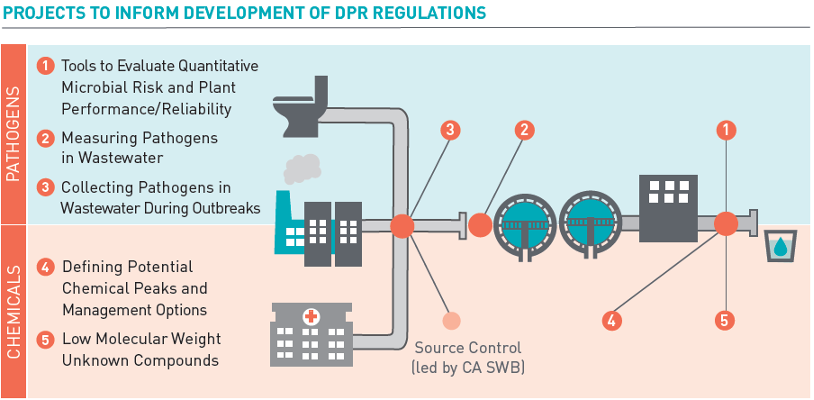
Figure 1. Priority research topics for DPR regulatory development identified by the State Water Board.
DPR-1: Adopt the use of probabilistic methods to evaluate treatment performance and quantitative microbial risk assessment (QMRA). As California moves to DPR, there will be an increasing and unprecedented reliance on engineered solutions for public health protection. The ability of these systems to provide equivalent degrees of protection to IPR projects that include environmental buffers necessitates further investigation and evaluation. Both probabilistic assessments of treatment train performance and QMRA offer unique opportunities to understand the reliability of DPR systems. This research team is developing a freely available, user-friendly tool that can be used to quantify and characterize pathogen risk (QMRA) in DPR applications based on an evaluation of a probabilistic assessment of treatment train performance (PATTP).
The QMRA tool is a model that allows the State to evaluate and identify what log reduction values (LRVs) – i.e., performance requirements – are necessary to achieve different levels of public health protection from waterborne pathogens. For utilities, the tool can help in understanding how different DPR treatment trains can reliably meet risk goals. In particular, the tool provides a metric to evaluate the LRVs of viruses, Cryptosporidium, and Giardia needed to achieve a risk of infection below acceptable thresholds: Both 10-4 per person per year and 2.7×10-7 per person per day. This approach provides a tractable metric for evaluating overall treatment plant reliability including treatment process redundancy and robustness (multiple barriers).
The tool input, as seen in Figure 2, allows the user significant flexibility to define various conditions that could impact plant performance reliability and risk determinations. Figure 3 illustrates the tool output: risk curves that show a probability distribution relative to the defined acceptable risk level and plant performance curves describing the reliability of a treatment system. Reliability information is useful to ensure that DPR provides equal or greater protection to public health as conventional drinking water supplies. The tools can also help identify which features of a DPR system can be used to promote reliability, including the benefits of redundancy in treatment and the use of a diverse, robust set of treatment barriers. These insights help confirm treatment criteria for the control of pathogens.
The project principal investigator (PI) is Dr. Brian Pecson (Trussell Technologies) assisted by the research team, including Drs. Edmund Seto (University of Washington) and Dan Gerrity (University of Nevada), and the Technical Work Group (TWG), which includes Drs. Nick Ashbolt (University of Alberta), Charles Haas (Drexel University), and Theresa Slifko (Metropolitan Water District – MWD).
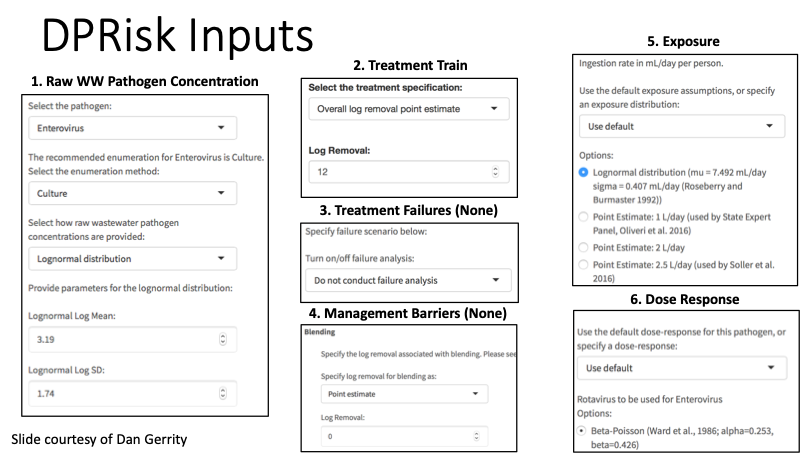
Figure 2: DPRisk Tool Inputs
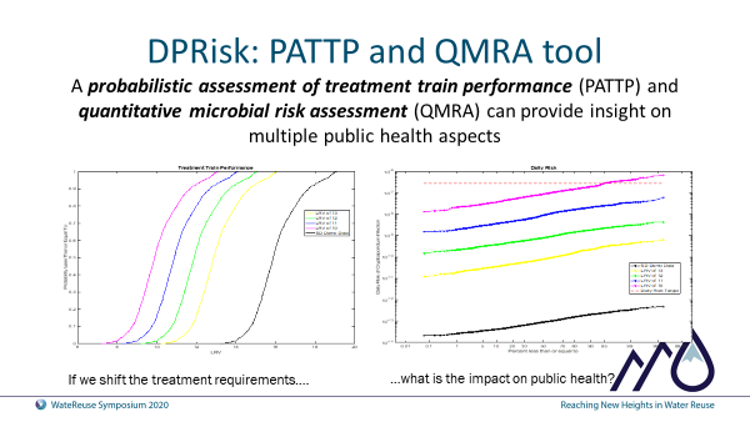
Figure 3: DPRisk Tool Outputs – PATTP performance curves and risk curves
While DPR-1 focuses on plant performance and reliability with the aim to characterize risk and associated LRVs, DPR-2 provides the necessary pathogen data in raw wastewater to allow for DPR-1 evaluation and determination (Figure 4). The risk-based framework used to develop the existing potable reuse regulations (i.e., GRRP and SWA) is based on the pathogen log reduction that is required to reduce pathogen concentrations in raw wastewater to acceptable levels in the treated water for reuse. Consequently, one of the key data inputs for this process is accurate information on the concentration of key waterborne pathogens in the source water, i.e., in raw wastewater. To better inform decisions associated with developing LRV requirements and conducting probabilistic-based QMRA and plant performance modeling, the SWB funded DPR-2 to assess the concentration of waterborne pathogens in raw wastewater over a 14 month-long campaign. Key principal objectives of the research are to:
1. Collect empirical data on the concentration and variability of pathogens on key selected pathogens in raw wastewater for the purpose of verifying log removal values necessary to adequately protect public health in DPR projects (including method development, standardization, and validation).
2. Develop recommendations for the collection and analysis of samples and data interpretation on pathogens in raw wastewater for use both in the 14 month-long campaign (began November 2019) and in defining future regulatory monitoring requirements.
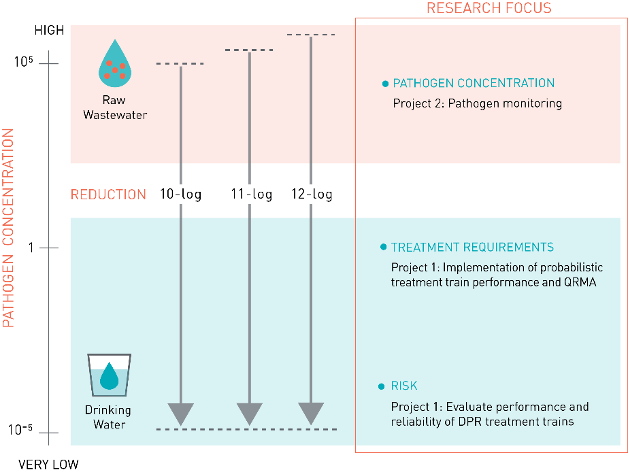
Figure 4: Inter-Relationship Between DPR-1 and DPR-2 Investigations
The monitoring campaign, to be completed in the spring of 2021, is assessing the raw (untreated) wastewater at five large California wastewater agencies located in San Diego, Orange County, Los Angeles (2 agencies), and San Francisco (see Figure 5) to provide more complete information on the concentrations and variability of various waterborne pathogens and indicators. When completed, the research will provide industry’s largest dataset of raw pathogen concentrations and the high-quality pathogen data will enable the development of regulations.
The research team also refined current laboratory methods with new standard operating procedures (SOPs) that address limitations of previous monitoring efforts and set a new bar for wastewater monitoring. The SOPs were developed through literature review and a robust methods pre-testing study, followed by further refinement through a methods optimization study using multiple wastewaters. Preliminary results of the optimized analysis procedures are shown in Figure 6. The updated methods cover a suite of pathogens and indicators, including: enterovirus and adenovirus (culture and molecular methods), norovirus (molecular), bacteriophage (culture and molecular), Giardia and Cryptosporidium (microscopy). All procedures are contained online in the DPR-2 Quality Assurance Project Plan (QAPP). In addition to key waterborne pathogens, the researchers have added SARS-CoV-2 to the list of organisms of concern and optimized methods to analyze for SARS-CoV-2 in untreated wastewater samples. The SARS-C0V-2 monitoring program was initiated in March 2020 and will run through January 2021.
Dr. Brian Pecson (Trussell Technologies) is the PI and the TWG includes Drs. Theresa Slifko (MWD, Chair), George DiGiovanni (MWD), Menu Leddy, Kara Nelson (University of California at Berkeley), Channah Rock (University of Arizona). Laboratory participants include Dr. Yeggie Dearborn (Cel Analytical), Dr. George Luskin (BCS Laboratories), and Dr. Fu-Chih Hsu (Scientific Methods). The external Quality Assurance officer is Walter Jakubowski (WaltJay Consulting).
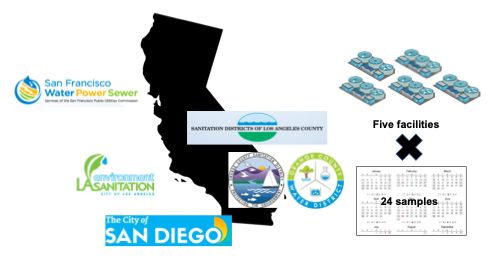
Figure 5: Five California Utilities Participating in Pathogen Monitoring Campaign
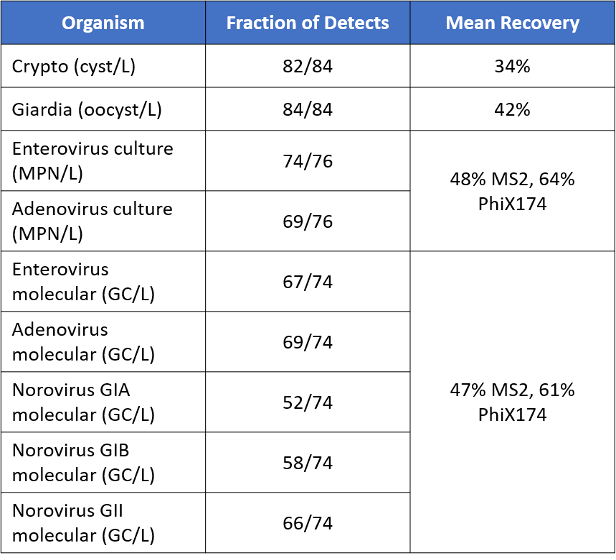
Table 1: Preliminary results of optimized procedures for an untreated wastewater matrix, data from 12/2019 to 9/2020. High rate of detection for all organisms, effective for wastewater from 5 different facilities, and reproducible across 3 different labs. Matrix spike samples provide ability to correct for recovery.
Information collected as part of a focused literature review on specific pathogens and public health surveillance and data collected as part of the DPR-2 pathogen monitoring campaign will be used to help frame and address the following questions:
In addition to several key waterborne pathogens (i.e., Crytosporidium and Giardia spp. and norovirus), the researchers have added coronavirus to the list of organisms of concern. The project PI is Dr. Krista Wigginton (University of Michigan) and the TWG member is Dr. Tim Wade (U.S. EPA).
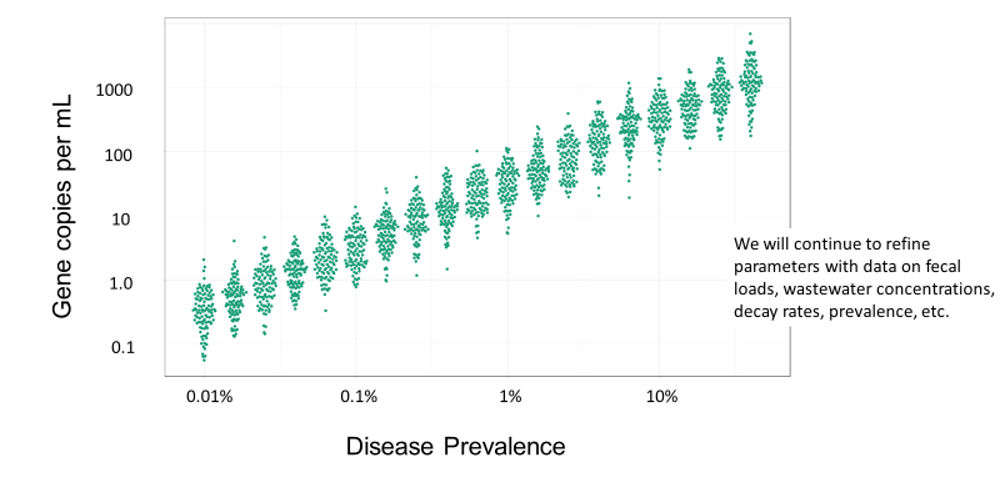
Figure 7: A model linking norovirus concentrations in raw wastewater to prevalence.
DPR-4: Treatment for averaging potential chemical peaks.
The goal of this project is to investigate and identify suitable options (e.g., treatment, monitoring, operations, and source control) that can provide some “averaging” with respect to potential chemical peaks, particularly for chemicals that have the potential to persist through advanced water treatment. Averaging can take the form of a treatment process that causes the removal or transformation of a contaminant, or averaging can be a blending or dilution scheme to reduce chemical peaks to background levels. In addition, defining a chemical peak is a key component of the project.
The project is broken into three phases. Phase 1 is a detailed literature review of the rejection of chemical constituents or surrogates by several individual processes or a combination of treatment processes. Example findings include the rejection of various organic compounds by RO (Figure 8) and by advanced oxidation (AOP) (Figure 9). The phase also includes an assessment of the types of chemicals that may be addressed with industrial source control enhancement, identification of and definition of the term “peak” when statistically considering influent concentration, treatment process performance, analytical variability and duration, and identification of frequency of sampling/monitoring needed to effectively enable the identification of “peaks”.
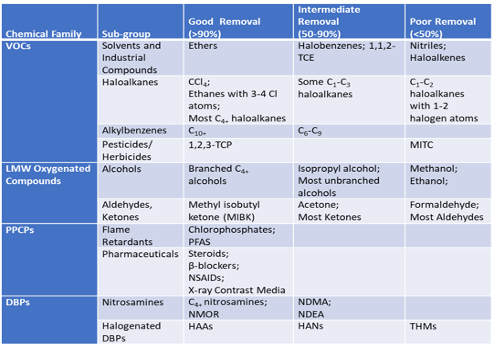
Figure 8 – Summary of RO rejection of organic compounds and chemical families. (Howe 2019, Zeng 2016, Rodriguez 2011, Snyder 2007, Kiso 2011, Tackaert 2019, Fujioka 2012; Doederer 2014)
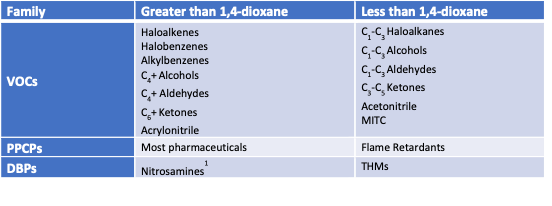
Figure 9 – Predicted removal of organic compounds via AOP (Drewes 2008, Howe 2019, Ahmed 2017, Drewes 2006, Buxton 1988, Swancutt 2010)
Phase 2 involves the preparation of a case study report on three utilities (City of San Diego, California; Orange County Water District, Fountain Valley, California; and the Singapore Public Utilities Board) from surveys on their experiences of detected chemical peaks, as well as response protocols, during such events. In one such example, a discharge of acetone in the recycled water used for IPR at the OCWD Groundwater Replenishment System manifests in the RO product water (Figure 10).
The case study report evaluates the impact of illicit discharges for different sewersheds (e.g., a drainage basin or catchment area) and chemical volumes and identified available options for chemical peak “averaging” (e.g., effective treatment processes, enhanced source control programs, and operating protocols). Figure 11 depicts how the duration of an illicit discharge to a watershed impacts both the peak concentration of a chemical and the length of time that the peak occurs.
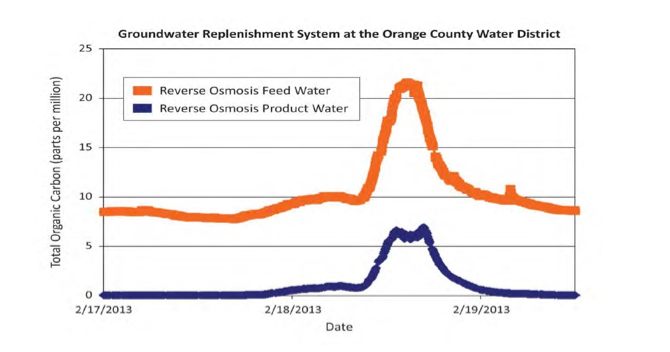
Figure 10 – Chemical Peak at Full-Scale Potable Reuse Facility. Results from online monitoring of total organic carbon (before and after RO) at the Orange County Water District’s Groundwater Replenishment System in February 2013 (Dadakis and Dunivin, 2013) from Olivieri et al. (2016)
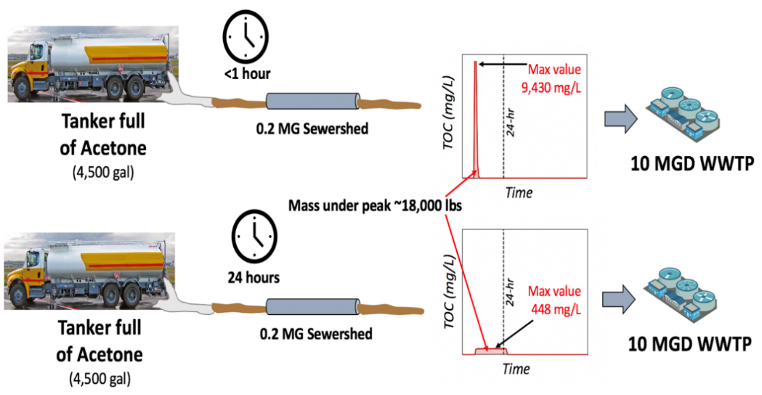
Figure 11. Impact of illicit discharge duration on chemical peak.
Phase 3 includes experimentation to address knowledge gaps, including identifying chemicals and chemical groups of concern. Experiments were conducted in this phase to evaluate the ability of total organic carbon (TOC) analyzers to measure specific chemicals that should be targeted for reduction/removal in different water matrices. Subtasks in Phase 3 include pre-testing of laboratory sampling and analysis procedures, round-robin sampling studies (under the direction of Dr. Eric Dickenson, Southern Nevada Water Authority), evaluation of online and laboratory TOC meters, and data analysis and reporting in a final report.
The project Co-PIs are Drs. Jean Debroux (Kennedy/Jenks), Shane Trussell (Trussell Technologies), and Megan Plumlee (OCWD). The research team members include Dr. Stephen Timko Kennedy/Jenks), and Dr. Aleks Pisarenko and Rodrigo Tackaert (Trussell Technologies).
Current analytical methods are capable of monitoring hundreds of known trace organic compounds (TOrCs). However, they fall short of addressing all chemicals of interest, including transformation products and otherwise unknown chemicals that may occur in source and product water. Assuming RO/AOP as the de facto requirement for DPR treatment trains, low molecular weight (LMW) compounds that can penetrate RO membranes are of particular interest. The goals of the DPR-5 project are to:
1. Document the current state‐of‐the‐science for analytical methods that target and identify unknown TOrCs in potable reuse
2. Develop a research plan to evaluate the utility of the most promising methods for identifying unknown TOrCs,
3. Outline a communications strategy for regulators, managers, and the general public regarding monitoring of unknown TOrCs using these methods.
The DPR-5 final report provides a synopsis of the current state‐of‐the‐science for analytical methods to identify and measure unknown TOrCs in potable reuse, and to provide recommendations by which to continue to advance the science of such methods as well as to adapt them for use in the management of CECs. The report proposes an integrated framework that includes targeted analysis of known LMW compounds that are anticipated to make it through the treatment train, as well as semi‐ and non‐targeted analysis (NTA) of unknown contaminants by both instrumental methods and by bioassays, along with the advantages and limitations of each approach. Such a screening approach is included the recent California Science Advisory Panel for CECs in recycled water (Drewes et al. 2018) and was implemented in the SWB’s Recycled Water Policy.
The report notes that, at present, NTA can be used as an investigative tool to complement the existing suite of other analytical tools such as available bioassays (ER-α and AhR) to identify unknown TOrCs in potable reuse. However, standardization of NTAs would move the science forward, in part to help develop better targeted methods, as noted in DPR-5’s integrated framework.
In the framework for unmonitored TOrCs (aka CECs), non‐targeted analysis for unknowns complements targeted methods, especially when targeted methods fail to identify problematic TOrCs (Figure 12). But using any method, including NTA, as a stand-alone monitoring approach for TOrCs monitoring in potable recycled water may miss valuable information on the identification, quantification, and evaluation of the effects of CECs (Drewes et al. 2018).
As with targeted methods and bioassays, NTAs involve extracting and concentrating TOrCs from a sample and then analyzing the sample to detect chemicals, which may number in the thousands and may or may not pose a risk to human health. For NTA, this analysis is typically done by mass spectrometric means (e.g. LC-QTOF, LC-QQQ). With mass spectrometry, a molecular fingerprint of each chemical peak can be generated that allows for tentative identifications of the chemicals through matching with known chemical fingerprints in compound screening libraries. Under NTA, this process can generate extensive volumes of data.
However, tentative peak identifications would have to be followed up with targeted chemistry to confirm the presence of the tentatively identified peaks and to determine if the chemical is present at a concentration of concern to human health.
Consequently, the state of the science for NTA is largely qualitative and the infrastructure, expertise, effort/time, and ultimately cost to perform suspect screening and non‐targeted analysis of known unknowns and unknown unknowns greatly outdistances the cost to perform surrogate, targeted, and semi‐targeted cell bioassay analyses (Snyder 2014; Leusch and Snyder 2015; Drewes et al. 2018).
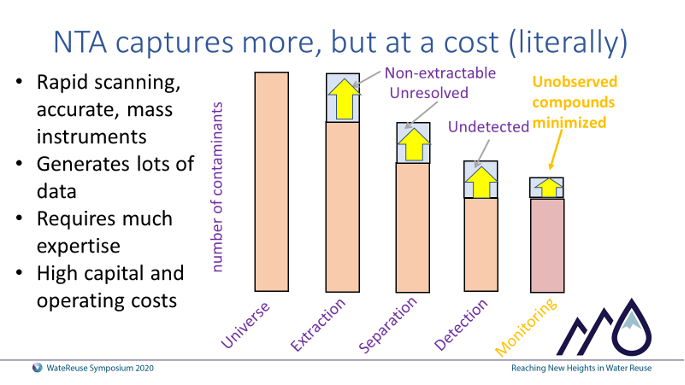
Figure 12. NTA – is it ready and available for routine monitoring?
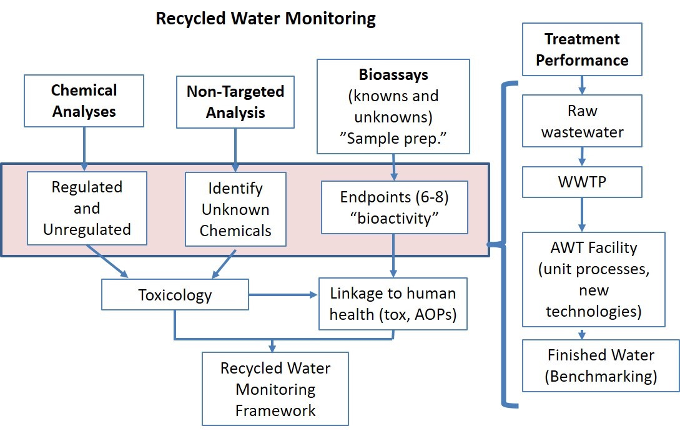
Figure 13. Non‐Targeted Analysis Complements Current “Targeted” Chemical Analyses and Newly Developed Bioanalytical Tools for Monitoring Recycled Water Quality and for Assessing Treatment Performance. Adapted from Drewes et al. 2018.
In summary (Figure 13), both targeted and non‐targeted analysis (by both instrumental and bioassay) can be integrated parts of the screening and monitoring for occurrence of low molecular weight compounds in waters. Targeted analysis is valuable for monitoring for known TOrCs of concern, particularly those with defined action levels for regulatory and compliance purposes. Targeted analysis can trigger the necessity for non‐targeted analysis on its own, depending on criteria (e.g., all natural waters at a specific site are suspected to have compounds not routinely measured by targeted analysis, or may contain transformation products that are problematic). Bioassays (Denison et al., 2020) can provide a measure of overall toxicity to an endpoint of interest, which itself can trigger appropriate targeted or non‐targeted instrumental analysis (e.g., if overall toxicity exceeds that of known chemical constituents) to identify unknown compounds of concern, or even quantify them as standards become available. For recycled water, these integrated approaches can be applied to various stages of advanced water treatment to evaluate occurrence and effects of known and unknown TOrCs of interest and concern.
DPR-5 proposes a phased five-year research plan, at an estimated cost of $1.2M, to evaluate the utility of using NTA for identifying LMW unknown TOrCs in recycled water. The State Water Board maintains an active interest in evaluating and advancing the state-of-the-science for NTA as an analytical tool that can provide complimentary information to surrogate, targeted chemistry, and bioassays to help identify LMW unknown TOrCs in potable recycled water. Such advances would increase the readiness and utility of NTA as part of the recommended integrative framework proposed by the DPR-5 final report. Finally, a communications strategy is outlined for regulators, managers, and the general public with regards to monitoring for unknown TOrCs using the methods discussed.
The project PIs are Drs. Charles Wong and Keith Maurya (Southern California Coastal Water Research Project) and the TWG includes Drs. Shane Snyder (University of Arizona and NTU Singapore) and Eunha Hoh (San Diego State University).
The State Water Board is currently reviewing the research and evaluating the findings provided by the research so far. SWB is relying on the research to fill in some of the knowledge gaps in developing uniform water recycling criteria for DPR that is protective of public health. For instance, probabilistic QMRA can be used to assist in developing the required pathogen log removal values for the pathogen control criteria, and the chemical averaging research will be helpful in the development of chemical control criteria needed for DPR when the protective environmental buffer that is available in indirect potable reuse becomes very small or reduced completely in DPR.
The State Water Board anticipates establishing the expert panel to review proposed criteria in the second quarter of 2021. The State Water Board’s DPR website provides more information on the framework for regulating DPR and the news and information regarding the development of DPR criteria, including how to engage in the public process associated with the development of these regulations.
References
Ahmed, M.B., et al. (2017) Progress in the biological and chemical treatment technologies for emerging contaminant removal from wastewater: A critical review. Journal of Hazardous Materials 323, pp 274-298
Anderson, P., Denslow, N., Drewes, J. E., Olivieri, A., Schlenk, D., & Snyder, S. (2010). Final report monitoring strategies for chemicals of emerging concern (CECs) in recycled water. Recommendations of a Science Advisory Panel. Convened by State Water Resources Control Board
Buxton, G.V., C.L. Greenstock, W.P. Helman, A.B. Ross. (1988) Critical Review of Rate Constants for Reactions of Hydrated Electrons, Hydrogen Atoms and Hydroxyl Radicals (•OH/•O-) in Aqueous Solution.” Journal of Physical and Chemical Reference Data 17 pp 513-886.
California Code of Regulations (CCR) Regulations Related to Recycled Water. (2015) Title 22, section 60320. State Water Resources Control Board.
California Water Code (CWC) AB 574 (2016). Division 7 – Water Quality, Chapter 7.3 – Direct and Indirect Potable Reuse, Section 13560.
Dadakis, J. and Dunivin, B. (2013) February 2013 Acetone/TOC Occurrence. Panel, G.R.S.N.I.A. (ed).
Denison, M., Mehinto, A., Olivieri, O., Plumlee, M., Schlenk, D., Thompson, S., & Waggoner, C. (2020) Bioanalytical Tools for Detection and Quantification of Estrogenic and Dioxin-Like Chemicals in Water Recycling and Reuse: Guidance Document for Developing a Standard Operating Procedure. NWRI.
Doederer, K., M.J. Farré, M. Pidou, H.S. Weinberg, and W. Gernjak (2014) Rejection of disinfection by-products by RO and NF membranes: Influence of solute properties and operational parameter. Journal of Membrane Science 467 pp 195-205.
Drewes, J. E., Anderson, P., Denslow, N., Jakubowski, W., Olivieri, A., Schlenk, D., & Snyder, S. (2018). Monitoring Strategies for Constituents of Emerging Concern (CECs) in Recycled Water. Southern California Coastal Water Research Project, Technical Report 1032
Drewes, J. E., Anderson, P., Denslow, N., Olivieri, A., Schlenk, D., Snyder, S. A., & Maruya, K. A. (2013). Designing monitoring programs for chemicals of emerging concern in potable reuse–what to include and what not to include?. Water science and technology, 67(2), 433-439.
Drewes, J. E., Amy, G., Bellona, C., Filteau, G., Oelker, G., & Xu, G. (2008). Comparing nanofiltration and reverse osmosis for treating recycled water. Water Environment Research Foundation.
Drewes, J.E., Xu, P., Bellona, C., Oedekoven, M., Macalady, D., Amy, G. and Kim, T.-U. (2006). Rejection of Wastewater-Derived Micropollutants in High-Pressure Membrane Applications Leading to Indirect Potable Reuse, Report WateReuse Foundation, Alexandria, Virginia, USA.
Fujioka, T., et al. (2012) N-nitrosamine removal by reverse osmosis for indirect potable water reuse – A critical review based on observations from laboratory-, pilot- and full-scale studies. Separation and Purification Technologies 98, pp 503-515
Howe, K.J., Minakata, D., Breitner, L.N. and Zhang, M. (2019). Predicting Reverse Osmosis Removal of Unique Organics, Report The Water Research Foundation, Denver, Colorado and Alexandria, Virginia, USA.
Kiso, Y. et al. (2011) Pore radius estimation based on organic solute molecular shape and effects of pressure on pore radius for a reverse osmosis membrane. Journal of Membrane Science 369 pp 290-298
Olivieri, A., Crook, J., Anderson, M., Bull, R., Drewes, J., Haas, C., Jukubowski, W., McCarty, P., Nelson, K., Rose, J., Sedlak, D. and Wade, T. (2016). EXPERT PANEL FINAL REPORT: Evaluation of the Feasibility of Developing Uniform Water Recycling Criteria for Direct Potable Reuse, Report State Water Resources Control Board Division of Drinking Water, Sacramento, California, USA.
Snyder, S.A., S. Adham, A.M. Redding, F.S. Cannon, J. DeCarolis, J. Oppenheimer, E.C. Wert, and Y. Yoon, Role of membranes and activated carbon in the removal of endocrine disruptors and pharmaceuticals. Desalination, 2007. 202(1-3): p. 156-181.
Swancutt, K., et al (2010) Absolute kinetics and reaction efficiencies of hydroxyl-radical-induced degradation of methyl isothiocyanate (MITC) in different quality waters. Chemosphere 81, pp 339-344
Tackaert, R., et al (2019) Demonstrating process robustness of potable reuse trains during challenge testing with elevated levels of acetone, formaldehyde, NDMA, and 1,4-dioxane. Journal of Water Supply and Technology-AQUA. in press
Zeng, T., Plewa, M. J., & Mitch, W. A. (2016). N-Nitrosamines and halogenated disinfection byproducts in US Full Advanced Treatment trains for potable reuse. Water research, 101, 176-186.
Authors: Jim Crook(1), Adam Olivieri(2), Robert Brownwood(3), Jing Chao(3), Claire Waggoner(3), Erin Partlan(4), Julie Minton(4), Brian Pecson(5), Krista Wigginton(6), Jean Debroux(7), Shane Trussell(5), and Charles Wong(8)
1. Environmental Engineering Consultant
2. EOA, Inc.
3. California State Water Resources Control Board
4. The Water Research Foundation
5. Trussell Technologies, Inc.
6. Dept. of Civil and Environmental Engineering, University of Michigan
7. Kennedy/Jenks Consultants
8. Southern California Coastal Water Research Project